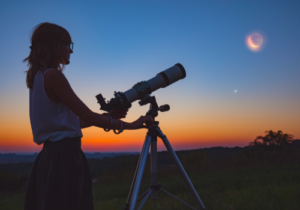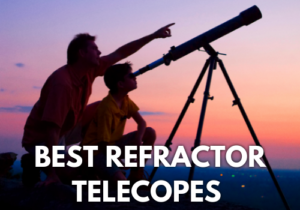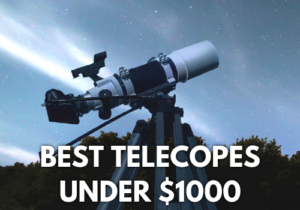
Best Small Telescope 2025; Reviews
Disclosure: This post contains affiliate links and I may earn a small commission (at no extra cost to you) if you click through and make a purchase. Thanks in advance – I really appreciate it!
To ensure we can provide you with all the information about the best small telescope, we spent multiple hours researching and going through customer’s reviews and specifications. We came out with 12 great products which have been assembled in the table below. We also wrote detailed reviews of each product to get full insight. Below it is the buying guide we crafted so that you know precisely what to look for and where to look.
COMPARISON TABLE
| Image | Title | Best For | Features | Price | Buy |
|---|---|---|---|---|---|
Top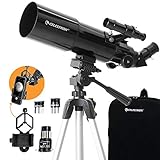 Top
Top
Top
Top
Top Top
Top
Top
Top
Top | Celestron - 80mm Travel Scope | Best For Beginners | Type: Refractor, Aperture: 80mm (3.15″), Focal length: 400mm, Focal Ratio: f/5 | See on Amazon | |
 Top
Top
Top
Top
Top
Top
Top
Top | Orion GoScope II 70mm Refractor | Best Portable | Type: Newtonian Reflector, Aperture: 70mm(2.75″), Focal length: 400mm, Focal Ratio: f/5.7 | See on Amazon | |
 Top
Top
Top
Top
Top
Top
Top
Top | Celestron - AstroMaster 90AZ | Best For Planets | Aperture: 90mm (3.54″), Focal length: 1000 mm, Focal Ratio: f/11 | See on Amazon | |
 Top
Top
Top
Top
Top
Top
Top
Top | Orion 10014 SkyQuest XT4.5 | Best Dobsonian | Type: Newtonian Reflector, Aperture: 114mm (4.5”), Focal length: 900mm, Focal Ratio: f/7.9 | See on Amazon | |
 Top
Top
Top
Top
Top
Top
Top
Top | Celestron - NexStar 90SLT | Best For DSOs | Type: Maksutov-Cassegrain, Aperture: 90mm (3.54″), Focal length: 1250mm, Focal Ratio: f/13.9 | See on Amazon | |
 Top
Top
Top
Top
Top
Top
Top
Top | Emarth Telescope, 70mm/360mm | Best For Kids | Type: Newtonian Reflector, Aperture: 70mm (2.75″), Focal length: 360mm, Focal Ratio: f/5.1 | See on Amazon | |
 Top
Top
Top
Top
Top
Top
Top
Top | Celestron - NexStar 4SE | Best For Astrophotography | Type: Maksutov Cassegrain, Aperture: 102 mm / 4.1″, Focal length: 1325 mm, Focal Ratio: f/13 | See on Amazon | |
 Top
Top | Orion 10012 SkyScanner | Best Reflector | Type: Reflector, Aperture: 100mm (3.94”), Focal length: 400mm | See on Amazon | |
 Top
Top
Top
Top
Top
Top
Top
Top | Celestron - 60LCM | Best GoTo | Type: Refractor, Aperture: 60mm (2.36”), Focal length: 700mm, Focal Ratio: f/12 | See on Amazon | |
 Top
Top
Top
Top
Top
Top
Top
Top | Celestron - 70mm Travel Scope | Best For Travel | Type: Reflector, Aperture: 70mm (2.8″), Focal length: 400mm, Focal Ratio: f/5.7 | See on Amazon | |
 Top
Top
Top
Top
Top
Top
Top
Top | Meade Instruments – Infinity 70mm | Best Refractor | Type: Refractor, Aperture: 70 mm (2.8″), Focal length: 700mm, Focal Ratio: f/10 | See on Amazon | |
 Top
Top
Top
Top
Top
Top
Top
Top | Celestron - PowerSeeker 70EQ | Best For Astronomy | Aperture: 70mm (2.8″), Focal length: 700mm, Focal Ratio: f/10 | See on Amazon |
Product prices and availability are accurate as of the date/time indicated and are subject to change. Any price and availability information displayed on [relevant Amazon Site(s), as applicable] at the time of purchase will apply to the purchase of this product.
Prices pulled from the Amazon Product Advertising API on: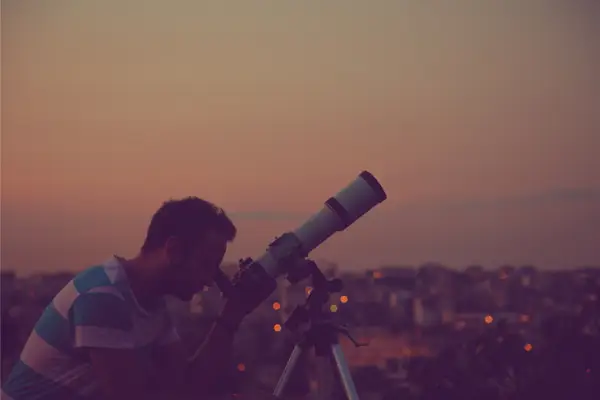
Best Small Telescope
With so many models with so many features available today, it can be a tedious task to find the best small telescope. We have analyzed the main features ( aperture, focal length, ratio, portability, affordability etc.) that make a good compact telescope that you can use to enjoy the night sky and fulfill your love for astronomy.
Best For Beginners
Celestron – 80mm Travel Scope
- Type: Refractor
- Aperture: 80mm (3.15″)
- Focal length: 400mm
- Focal Ratio: f/5
- Mount: Alt-Azimuth
- Eyepiece: 20mm, 10mm
- Magnification: 20x, 40x
- Weight: 6 lbs.(2.5 kg)
- Our Rating: 8/10
Prices pulled from the Amazon Product Advertising API on:
Product prices and availability are accurate as of the date/time indicated and are subject to change. Any price and availability information displayed on [relevant Amazon Site(s), as applicable] at the time of purchase will apply to the purchase of this product.
The Celestron Travel Scope 80mm f/5 AZ Refractor Telescope Kit is designed for portability and ease-of-use for both astronomical and terrestrial use. Its refractor-style optical tube has a respectable aperture that gathers the amount of light required to ensure views of the moon and planets remain bright and clear.
Included with this model of the Travel Scope is a universal smartphone digiscoping adapter that lets you capture photos and videos through the eyepieces for easy editing, enjoyment, and sharing.
This is no doubt one of the best small telescope for beginners as it’s very easy to set up and use.
Setting up the Travel Scope 80 is a breeze. You’ll be observing in no time. The telescope and its accessories can be assembled in just a few minutes, straight out of the box.
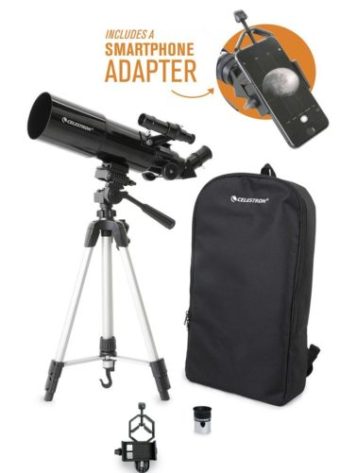
Adjustable tripod legs allow telescope height to be extended for taller observers, or retracted for placement on raised surfaces like a picnic table. Includes a tray to help you keep track of your eyepieces and other small accessories while observing.
Weighing at just 6 lbs (2.7kg) the entire set is very portable and you can take it with you anywhere and expect great optics and views. The backpack fits perfectly and gets full marks. The altazimuth mount ensures an easy and smooth movement which is important not only when tracking objects but also when you keep following them.
Celestron Starry Night Software is the premier astronomy software package on the market, providing resources and knowledge to view the solar system and beyond. Download it and learn about the night sky, celestial objects, and how to plan your next observing session.
With it;s manual Alt-Az mount, you can navigate the night sky with smooth precision using pan handle Alt-Az control with clutch. You can adjust the clutch in an up/down or left/right manner to track any object in the eyepiece.
Pros:
- 80mm aperture is ideal for lunar and planetary viewing as well as terrestrial use
- Fast f/5 focal ratio ensures views remain bright
- Photo-style tripod
- Lightweight and durable aluminum legs
Cons:
- Finderscope could be better.
Best Small Portable Telescope
Orion 10034 GoScope II
- Type: Newtonian Reflector
- Aperture: 70mm(2.75″)
- Focal length: 400mm
- Focal Ratio: f/5.7
- Mount: Altazimuth
- Eyepiece: 25mm, 10mm
- Magnification: 16x, 40x
- Weight: 3.5 lb / 1.6 kg
- Our Rating: 8.6/10
Prices pulled from the Amazon Product Advertising API on:
Product prices and availability are accurate as of the date/time indicated and are subject to change. Any price and availability information displayed on [relevant Amazon Site(s), as applicable] at the time of purchase will apply to the purchase of this product.
The Orion 10034 GoScope II 70mm Refractor Travel Telescope Moon Kit is a specifically designed telescope for advanced moon viewings from one of the best telescope brands in the world.
The affordable Orion GoScope II 70mm Refractor Travel Telescope features a 70mm achromatic lens system for sharp images of distant subjects.
This provides high quality, crisp and sharp images of distant objects. The resulting images are far better than other telescopes in this price range.
This 400mm focal length telescope (f/5.7) is perfect for daytime birding use as well as viewing wildlife, scenery and nighttime observing of the Moon and bright planets with the entire family.
The telescope includes 5×24 finder scope and two 1.25″ telescope eyepieces (25mm and 10mm) for 16x and 40x magnification.
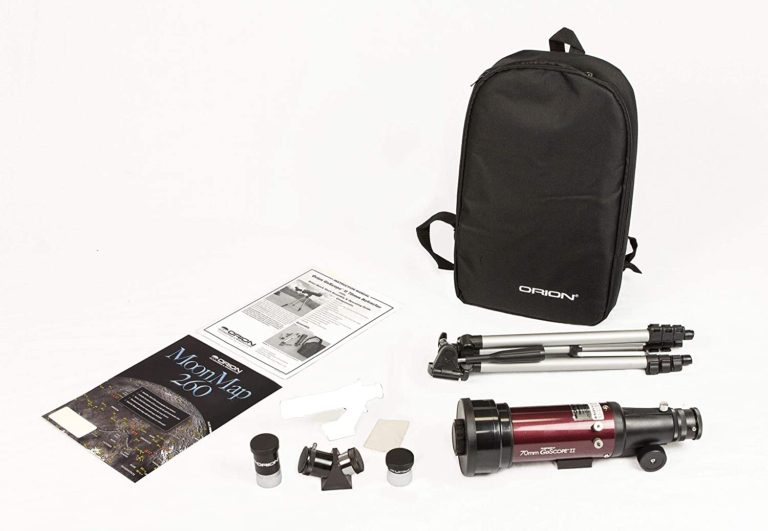
It also comes with the Orion MoonMap 260 which helps you and your family learn more about the Moon and it’s surface.
Its light weight of just 3.5 lbs. makes it easy for kids and beginners to take the telescope anywhere.
Is is most certainly one of the best small telescopes if you are interested in observing the moon from your backyard.
The telescope and its aluminum tripod can be easily stored and carried to your favorite observing location in it’s included backpack.
The Orion 10034 GoScope Refractor Travel Telescope is one of the best small travel telescopes for in regards to value for money, and is a great tool for travelling and outdoors activities. It’s light, easy to use and doesn’t require extensive knowledge of either telescopes or astronomy.
You will find a lot of uses for the respectable optics of the Orion GoScope II 70mm Refractor Travel Telescope, and a lot of times and places to use them, day or night.
Pros:
- Lightweight aluminum tripod for beginners and families on the go
- Rugged and robust, hence will last you a long time
- Good value for money
- Decent optics for the price
Cons:
- Does Not come with instruction manual
- Not suitable for professional use
Related
Best For Planets
Celestron – AstroMaster 90AZ
- Aperture: 90mm (3.54″)
- Focal length: 1000 mm
- Focal Ratio: f/11
- Mount: Alt-az
- Eyepiece: 20mm, 10mm
- Magnification: 50x, 100x
- Weight: 20 lbs.(9.1 kg)
- Our Rating: 9.4/10
Prices pulled from the Amazon Product Advertising API on:
Product prices and availability are accurate as of the date/time indicated and are subject to change. Any price and availability information displayed on [relevant Amazon Site(s), as applicable] at the time of purchase will apply to the purchase of this product.
The Celestron AstroMaster 90AZ altazimuth refractor is a perfect choice for a beginner who is looking to buy their first telescope to venture into astronomy and enjoy the night sky.
This reasonably priced 90 mm aperture refractor optical system is a good way to begin your journey into the night sky, as well as exploring nature during the day.
It provides you with detailed high-contrast views of the Moon and planets in the heavens, as well as sharp views of birds and animals across a lake or across the way.
For the astronomy enthusiast whose interests are the brighter solar system and deep space objects, the AstroMaster 90AZ has a lot to offer.
Its 3.5″ aperture has a light grasp 165 times that of the sharpest eye for nighttime use. Its large aperture and diffraction-free images make it surprisingly good for much deep space observing.
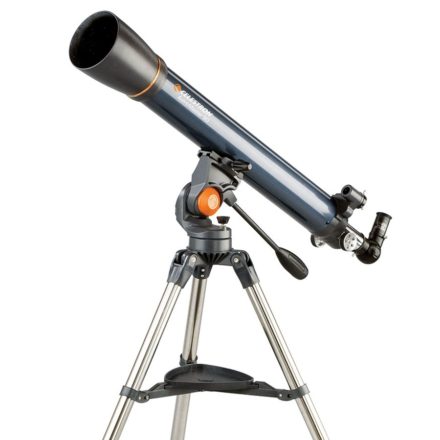
This version of the AstroMaster comes with two eyepieces (Sirius Plossl 20 mm,10 mm) that yield low and medium magnifications, and a 90° diagonal that sports an integrated erecting prism to correct images and allow the scope to be used as a conventional spotting scope for terrestrial use.
When used for astronomical viewing, the AstroMaster 90AZ yields breathtaking views of the Moon, Saturn with its ring structure, Jupiter and its belts and moons, nebulae, and star clusters.
The telescope features all-glass optical elements as well as smooth-operating steel tripod mountings featuring manual motion controls.
Additionally, the optics are coated for enhanced image brightness and clarity.
Upon its purchase, you can also download Celestron’s Starry Night Software and learn about the night sky, celestial objects, and plan your next stargazing session.
Pros:
- Great optics
- Great images of the moon and planets as well as terrestrial images
- Perfect for beginners as their first telescope
- Stable tripod
Cons:
- Finderscope could be better
Best Compact Dobsonian
Orion 10014 SkyQuest XT4.5
- Type: Newtonian Reflector
- Aperture: 114mm (4.5”)
- Focal length: 900mm
- Focal Ratio: f/7.9
- Mount: Dobsonian
- Eyepiece: 25mm, 10mm
- Magnification: 36x, 91x
- Weight: 22 lbs. (10kg)
- Our Rating: 9.2/10
Prices pulled from the Amazon Product Advertising API on:
Product prices and availability are accurate as of the date/time indicated and are subject to change. Any price and availability information displayed on [relevant Amazon Site(s), as applicable] at the time of purchase will apply to the purchase of this product.
The Orion SkyQuest XT4.5 Classic Dobsonian telescope has been designed with ease-of-use in mind. It’s a true “Dobsonian” telescope, having all the great features and value that make the Dobsonian reflector design so popular.
The SkyQuest XT4.5 collects a whopping 260% more light than a typical 60mm-aperture beginner telescope – which simply means hundreds more objects will be visible through this classic dobsonian.
With it’s 4.5″ aperture and 900mm focal length you can have the clear views of lunar craters and plains on the Moon, planets, bright nebulas and galaxies.
You can even see Jupiter’s cloud band, Saturn’s rings.
The XT4.5 is easily the best small dobsonian telescope as it is compact and lightweight compared to its competitors.
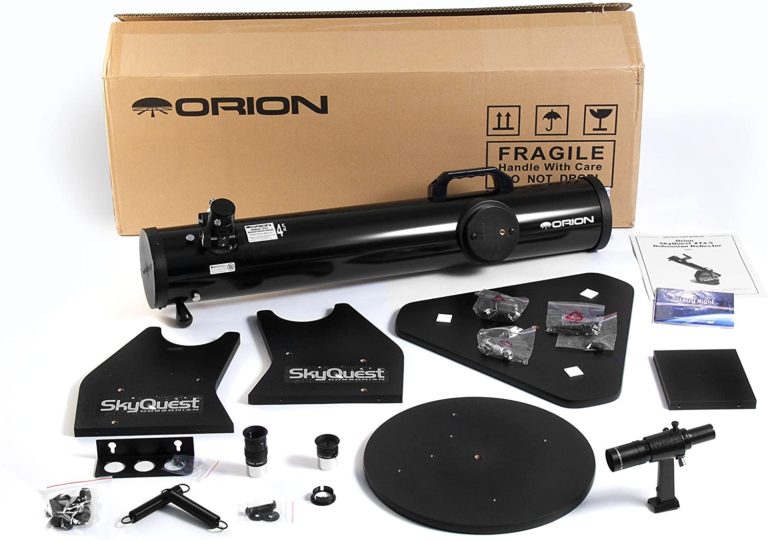
The Orion SkyQuest XT4.5 comes with some amazing accessories. You get a 6×26 Orion achromatic correct-image finder scope and a “navigation knob” for easy slewing of the telescope.
You also get two fully coated Orion 1.25″ Sirius Plossl eyepieces: a 25mm for low-power views at 36x, and a 10mm for getting in close at 91x.
The Orion SkyQuest XT4.5 is one of the best small telescope for beginners, it’s not a toy. It’s a quality astronomical instrument capable of delivering high-resolution images of astronomical objects.
The SkyQuest XT4.5 comes with a wooden Dobsonian base. The base also has some Nylon bearing pads, which prevent the scope from moving from position, allowing you to have a vibrations free viewing.
Pros:
- Affordable telescope with a great quality-price ratio
- Very good optical and mechanical performance
- Fully accessorized
- Perfect for amateurs with its simple and stable configuration
Cons:
- Short eyepiece height
- Plastic focuser
Best For Deep Sky Objects
Celestron – NexStar 90SLT
- Celestron - NexStar 90SLT
- Aperture: 90mm (3.54″)
- Focal length: 1250mm
- Focal Ratio: f/13.9
- Mount: Computerized – Alt-Azimuth
- Eyepiece: 25mm, 9mm
- Magnification: 50x, 139x
- Weight: 12 lbs (5.44 kg)
- Our Rating: 9.2/10
Prices pulled from the Amazon Product Advertising API on:
Product prices and availability are accurate as of the date/time indicated and are subject to change. Any price and availability information displayed on [relevant Amazon Site(s), as applicable] at the time of purchase will apply to the purchase of this product.
The Celestron NexStar 90SLT Black Mak Computerized Telescope is a perfect consideration for entry-level to mid-level astronomers. It is a compact instrument that possesses top-notch features at a reasonable price.
The Celestron NexStar 90SLT 90mm f/14 Maksutov-Cassegrain is one of the best small affordable computerized telescope as it gives you the ability to make detailed observations of the Moon, with the ability to easily see planets and reach outside the solar system to resolve bright deep-space objects like galaxies, nebulae, and binary or variables stars.
With preassembled, adjustable stainless steel tripods, and quick release fork arms and tubes, NexStar SLT telescopes can be set up in a matter of minutes with no tools required.
The brain of the NexStar SLT is the venerable NexStar computer controller. Equipped with a database of over 4000 objects, including the planets, stars, nebulae, galaxies, and the complete Messier catalog, it can also be programmed with up to 99 custom user-defined objects and filters for custom object lists.
Its intuitive menu-driven user interface provides the power to observe the heavens with nine slew speeds and three tracking rates, plus anti-backlash compensation.
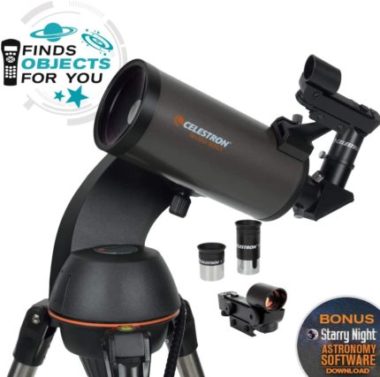
For users who want to learn more about the sky they are observing, the scope comes with Sky Astronomy Software. This software provides the user with information about the nighttime sky, celestial objects and sky maps to enrich the viewing experience.
The Maksutov-Cassegrain optical system’s Maksutov corrector lens is fully coated on both sides with anti reflective material for high light transmission and good contrast. A no-tool quick release dovetail connects the tube to the mount for fast set-up and take-down.
The scope comes with two eyepieces The first is a 25mm providing 50x magnification, which provides expansive views of the Moon, star clusters, and terrestrial observing. The second is a 9mm providing 139x for close-up views of the Moon and planets, globular star clusters, binary stars and more.
With the built-in SkyAlign technology, lining up your 90SLT on the sky each night takes only minutes. Simply input the date, time, and your location into the computer hand control, then use the StarPointer red dot finder to align the telescope on any three bright stars, or to two stars and a bright planet or the Moon. The NexStar computer will automatically align itself with the sky.
Pros:
- Excellent quality optics
- Compact, travel-friendly and portable
- Computerized go-to tracking
- Features “The Sky X” planetarium software
- Automatic alignment
Cons:
- Battery runs out quickly
Best For Kids
Emarth Telescope
- Type: Newtonian Reflector
- Aperture: 70mm (2.75″)
- Focal length: 360mm
- Focal Ratio: f/5.1
- Mount: Altazimuth
- Eyepiece: 25mm, 10mm
- Barlow Lens: 3x
- Magnification: 51x, 128x
- Weight: 2.87 lbs. (1.3 kg)
- Our Rating: 8.4/10
Prices pulled from the Amazon Product Advertising API on:
Product prices and availability are accurate as of the date/time indicated and are subject to change. Any price and availability information displayed on [relevant Amazon Site(s), as applicable] at the time of purchase will apply to the purchase of this product.
The Emarth travel telescope is one of the best small telescopes for the kids.
It’s equipped with a lens that has 360mm focal length and 70mm aperture. It comes with coated glass to make moon watching the best experience for the user.
It’s super easy to use and can be an excellent educational and fun gift for your child. If your child enjoys watching and exploring stars, then he or she will surely enjoy it’s 5×24 finder scope.
This model is very easy to assemble, and shouldn’t take more than a few minutes to set up.
It also comes with two eyepieces, a 10mm and a 25mm, which are slightly better than most eyepieces included at this price point.
It uses a BAK-4 prism for better viewing and it comes along with a solar system map.
The Travel Scope provides clean, crisp views. Developed with the traveler in mind,this travel scope features a compact and portable design perfect for the on-the-go stargazer.
Pros:
- Compact and lightweight, easy to carry
- Comes with its own carry case
- Easy to setup and use
- Perfect for kids
Cons:
- Small tripod
Best For Astrophotography
Celestron – NexStar 4SE
- Type: Maksutov Cassegrain
- Aperture: 102 mm / 4.1″
- Focal length: 1325 mm
- Focal Ratio: f/13
- Mount: Motorized; Alt-Azimuth Single Fork
- Eyepiece: 25mm
- Weight: 21.0 lb (9.5 kg)
- Our Rating: 9.2/10
Prices pulled from the Amazon Product Advertising API on:
Product prices and availability are accurate as of the date/time indicated and are subject to change. Any price and availability information displayed on [relevant Amazon Site(s), as applicable] at the time of purchase will apply to the purchase of this product.
Celestron’s NexStar 4SE 125mm f/13 Maksutov-Cassegrain GoTo Telescope is a powerful, versatile, and user-friendly catadioptric-style scope that can be used for observing everything from the Moon and planets to bright deep-sky objects like stars, galaxies, and nebulae.
The 4SE also has an integrated “flip mirror” at the back, which means that there is a built-in star diagonal which can be retracted to allow light directly out of the back of the telescope and into a camera adapter, usually for a DSLR or mirrorless camera.
Celestron’s NexStar 4SE’s big selling point for this model is the GoTo computer.
You can select from a database of 40,000 night sky objects. When you’ve picked a target, the motorized mount will slew the telescope around to point at the object you’ve chosen.
Once in your eyepiece, the motor will track it as it moves across the sky so you don’t lose sight of it.
Theoretically, this is a great solution for the more casual backyard astronomer who is more interested in spending time outside seeing objects than finding them.
The 4SE’s 102mm aperture isn’t huge, but the portability of this rig far outweighs any size limitation. And Celestron’s nicely coated optics make the most of every photon fetched.
If you want to get your feet wet with astrophotography, the 4SE has a camera control option. It helps you take a series of long duration exposures with your DSLR camera.
Just don’t try to hang a very heavy camera body on this little telescope; an oddly weighted mount won’t track well enough for sharp images.
Because it is a compound telescope, you are going to get picture-perfect images and a wide field of view. Of course, the StarBright XLT coating on the Celestron 4 SE helps, as does the inclusion of a 25 millimeter Plossl eyepiece that delivers 53 times magnification, as well as a 12.5 millimeter eyepiece that can be added to give you 100 times magnification.
As a result, this one of the best grab and go computerized telescope will be powerful enough to capture impressive details of many objects in our solar system, including the Moon, Jupiter, Mars and other planets.
Deep-sky objects, however, will appear less impressive than with a bigger aperture telescope.
The 4SE is so small and light, and the tripod folds so easily, you can quickly jump into almost any vehicle and drive to find dark skies.
And someday, if you grow into a larger telescope, you’ll probably want to keep this one as a “grab-and-go” scope. It’s great for chasing solar eclipses in faraway locations where you can’t lug a lot of luggage.
Pros:
- Very sharp optics
- Quality mount with acceptable gearing
- Acceptable aperture
- Good for DSLR astrophotgraphy
- Very stable
- Good included low-power eyepiece
- No collimation required
Cons:
- Small aperture for the price
Best Compact Reflector Telescope
Orion 10012 SkyScanner
- Type: Reflector
- Aperture: 100mm (3.94”)
- Focal length: 400mm
- Focal Ratio: f/4
- Eyepiece: 20mm, 10mm
- Magnification: 20x, 40x
- Weight: 6.2 lbs.(2.81kg)
Prices pulled from the Amazon Product Advertising API on:
Product prices and availability are accurate as of the date/time indicated and are subject to change. Any price and availability information displayed on [relevant Amazon Site(s), as applicable] at the time of purchase will apply to the purchase of this product.
The Orion SkyScanner is an affordable entry-level telescope which is perfect for amateurs and great for home astronomy as well.
The telescope’s ease of use and set-up makes it one of the best small telescope for the entire family where it can be enjoyed by young and old alike.
With the Skyscanner 100mm reflector telescope you can see the Moon in full detail, with craters and surface textures and shades; Jupiter, with its clouds and moons, in bright and clear images, especially if you live in a low light-polluted area.
You can also see Saturn with all its rings and its moon Titan, Mars, in good colours, depending on the time of year you look at it, the Pleiades star clusters and the Orion Nebula and Andromeda Nebula.
You will receive two eyepieces (20x and 40x magnification) with your purchase, to add some variety in the magnification power of your device.
The Orion SkyScanner features a very useful Orion EZ Finder II reflex sight that is capable of helping you bring forward the area you want to explore with great ease.
Since it is a compact version of a telescope, it is one of the best small telescopes for amateurs, beginners or kids.
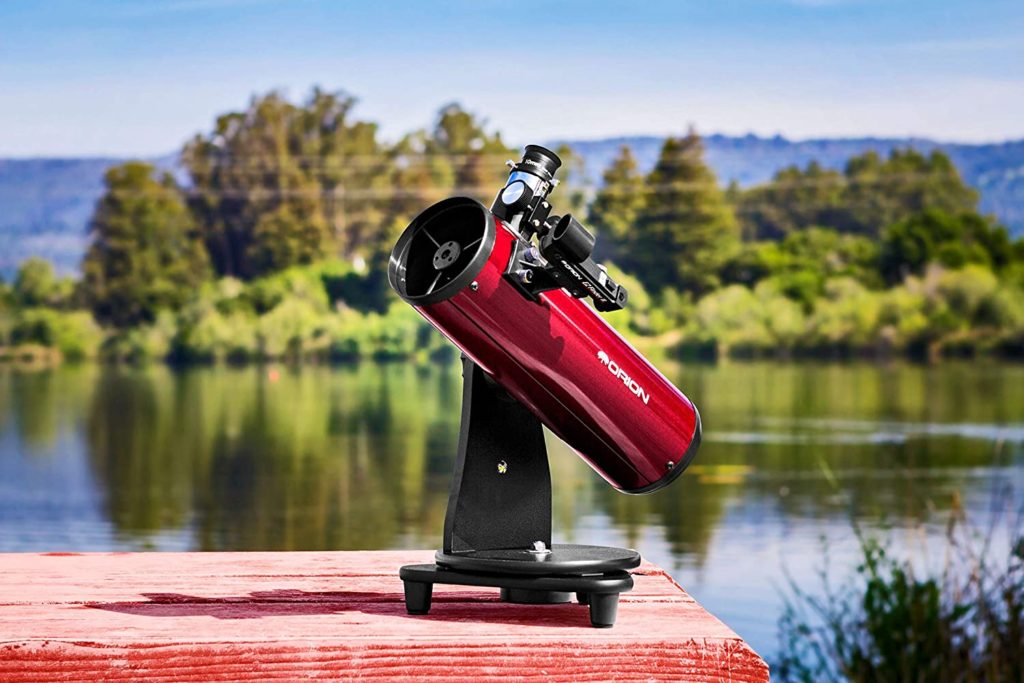
Its small size and light weight not only makes it one of the best small telescope for amateurs make it extremely portable. Moreover, consumers have reported that the scope can be set up within about 10 minutes of being removed from the box.
The telescope possesses a 100mm aperture, which is larger than apertures on other beginner telescopes and which is especially large considering the compact nature of the SkyScanner.
Along with the telescope, you get caps for the optical tube and focuser. The tube cap has an inner cap which can be removed for low power lunar viewing.
You also get free StarryNight Basic planetarium software, a DVD with programs giving a tour of the solar system, and an instruction booklet.
Although the Orion SkyScanner is a tabletop telescope, If there isn’t a table nearby, you can easily attach its wooden altazimuth base to a field tripod.
Pros:
- Strong entry-level scope
- Better value than super-low-cost telescopes
- 100mm aperture offers significantly more light than many entry-level telescopes
- Smooth focusing mechanism allows for greater image sharpness and control
- Comes with a variety of accessories
Cons:
- Better for wide-angle viewing at low power
- Tabletop mount offers good stability, but astrophotographers may want a tripod for greater stability
Best Small GoTo Telescope
Celestron – 60LCM
- Type: Refractor
- Aperture: 60mm (2.36”)
- Focal length: 700mm
- Focal Ratio: f/12
- Mount: Computerized – Alt-Azimuth
- Eyepiece: 9mm, 25mm
- Magnification: 28x, 78x
- Weight: 6.8 lbs.(4.5 kg)
- Our Rating: 9/10
Prices pulled from the Amazon Product Advertising API on:
Product prices and availability are accurate as of the date/time indicated and are subject to change. Any price and availability information displayed on [relevant Amazon Site(s), as applicable] at the time of purchase will apply to the purchase of this product.
The Celestron 60 LCM is light and portable with full GoTo capabilities, its a 60mm f/12 Computerized GoTo Reflector Telescope that features a 60mm objective lens configured in a refractor optical path that allows for detailed observation of the Moon and planets with true color rendition and very little distortion across the entire field of view.
This complete observation platform is ideal for beginner astronomers to learn celestial navigation or more experienced users who are looking for a basic grab-and-go option for quick sessions. It includes a motorized fork mount, a computer controller, two eyepieces, a 90° star diagonal, and a red-dot finderscope.
A sturdy aluminum tripod and accessory tray are included. The LCM mount features Celestron’s proven NexStar computer control technology with a database that allows the telescope to locate over 4,000 celestial objects.
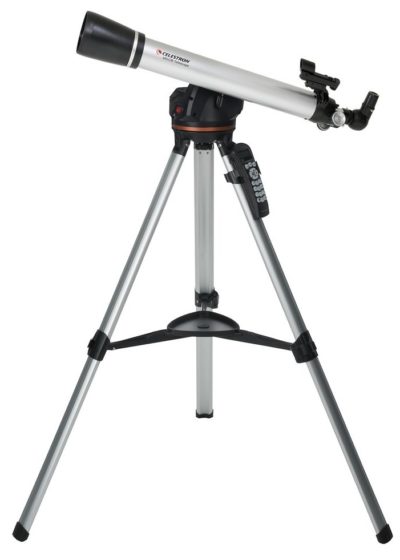
Celestron’s popular SkyAlign technology allows you to align on any three bright celestial objects, making for a fast and easy alignment process. An internal battery compartment prevents cord wrap during use.
It is compatible with optional Celestron NexRemote telescope control software, for advanced control of your telescope via computer.
No manual setting is required when you choose this particular device: the hard work has already been done for you. Users find it fascinating to watch almost everything they like to see through this telescope. It surpasses many of its competitors by offering more features that would enhance the experience of the user.
With this scope, maximum satisfaction is guaranteed. A hassle-free computerized device is a real deal for someone who doesn’t want all the stressful work of entering time, date, and other data before getting the feel of the galaxies.
Pros:
- Portable and lightweight
- Easy automated stars, planets, and galaxies tracking
Cons:
- Tripod is a bit shaky
Best Travel Telescope
Celestron – 70mm Travel Scope
- Type: Reflector
- Aperture: 70mm (2.8″)
- Focal length: 400mm
- Focal Ratio: f/5.7
- Mount: Alt-az
- Eyepiece: 20mm, 10mm
- Magnification: 20x, 40x
- Weight: 4.2 lbs (1.9 kg)
- Our Rating: 9/10
Prices pulled from the Amazon Product Advertising API on:
Product prices and availability are accurate as of the date/time indicated and are subject to change. Any price and availability information displayed on [relevant Amazon Site(s), as applicable] at the time of purchase will apply to the purchase of this product.
This telescope works great considering the fact that it is an inexpensive, portable scope. It provides wide, clear views of the sky that compare with much more expensive models.
The aperture performs surprisingly well given its size, and will most likely suit your needs given that it is a small, portable and one of the best small portable telescope to observe the night sky.
The Travel Scope also comes pre-assembled and ready-to-use, so you can just grab it and go.
Its an easy to use and easy to set up telescope and you don’t have to exert a lot of effort on the installation of this travel scope. Moreover, you don’t even need any tools or equipment to assemble the scope before using it.
The 2.76 inch aperture is well-suited for the purpose of this home telescope and provides bright and crisp views given its size.
All of its optical components are glass coated for an efficient performance. Nevertheless, the light weight tripod is readily adjustable made from pre assembled aluminum and silver finish.
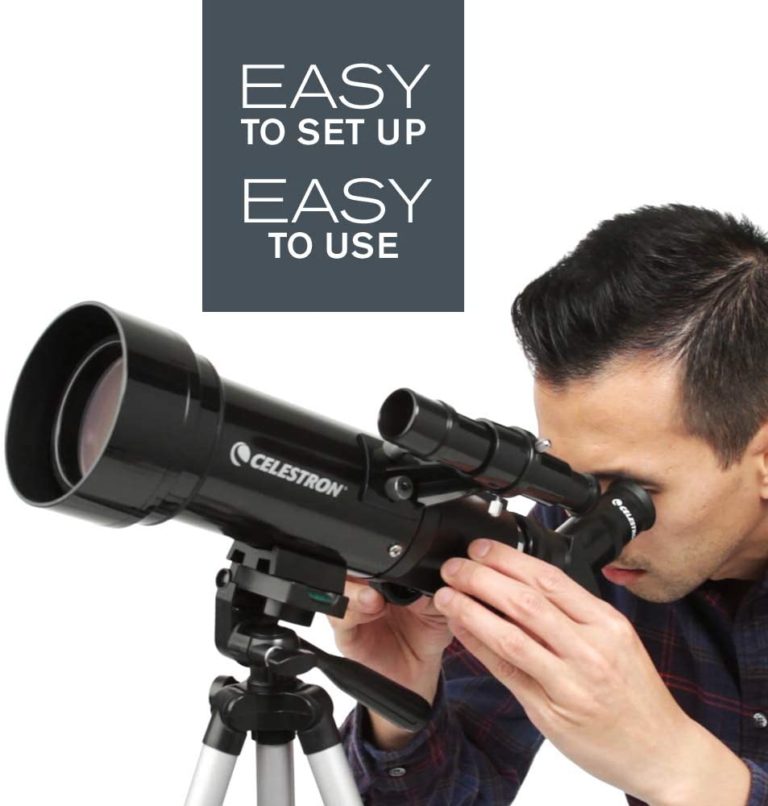
Incorporating a focal length of 400 mm, this device allows you to see clearly the rings of Saturn or the craters of the Moon. It should give you the magnification you need to spot the terrestrial objects you’re looking for in the night sky.
It is compactly built with the 70 mm refractor including two eyepieces used for high and low powered purposes. Nevertheless, the 20 mm eyepiece possesses 20x magnification while the 10 mm eyepiece has 40x magnification.
Also included is Sky X software, which allows you to learn the basics of astronomy and how to use your new telescope. Sky X is a great addition to any telescope and is an excellent tool to help beginners.
It features a smooth functioning altazimuth mount for easy location and shooting over several celestial bodies.
It is also suitable for astrophotography as it comes with a 2.5-degree field of view for greater scope and to enhance the picture quality that will be taken.
The Travel Scope is easy enough for any family member to use at home, it’s also a great telescope for more experienced astronomers will also be able to make great use of its features.
Pros:
- Easy to Use
- Perfect for home use
- Lightweight and highly portable
- Affordable Price
- Excellent optics
- Dual powered eyepieces
- Simple assembly
Cons:
- Shaky tripod
Best Refractor Telescope
Meade Instruments – Infinity 70mm
- Type: Refractor
- Aperture: 70 mm (2.8″)
- Focal length: 700mm
- Focal Ratio: f/10
- Mount: Alt-Azimuth
- Eyepiece: 26mm, 9mm
- Barlow Lens: 2x
- Magnification: 27x, 78x
- Weight: 13 lbs.(5.9 kg)
- Our Rating: 9.4/10
Prices pulled from the Amazon Product Advertising API on:
Product prices and availability are accurate as of the date/time indicated and are subject to change. Any price and availability information displayed on [relevant Amazon Site(s), as applicable] at the time of purchase will apply to the purchase of this product.
The Infinity 70mm is designed for beginners, the 70mm f/10 Alt-Azimuth Refractor Telescope from Meade is intended to introduce viewers to astronomy by giving them a complete set up for viewing the Moon, planets, and meteor showers.
It includes an altazimuth mount with a built in slow-motion control rod, for easy and quick tracking of celestial objects. This 70 mm (2.8″) Altazimuth Infinity Refractor Telescope by Meade delivers bright images and it is ideal for viewing both land and celestial objects.
The Infinity 70AZ is one of the best small telescope for viewing planets as it comes with two eyepieces: A 26mm eyepiece giving 27x and a 9mm one giving 78x. Meade also supplies a 2x Barlow allowing you to achieve 52x with the 26mm eyepiece and 156x with the 9mm eyepiece.
The telescope is offered with anti-reflection fully multi-coated optics. This enhances the ruggedness of the telescope, keeping the lenses functioning optimally. Even with the coating, the lenses allow in enough light to offer bright and crisp images. With fold-down rubber eyecups, the lenses are kept secure when the telescope is not in use.
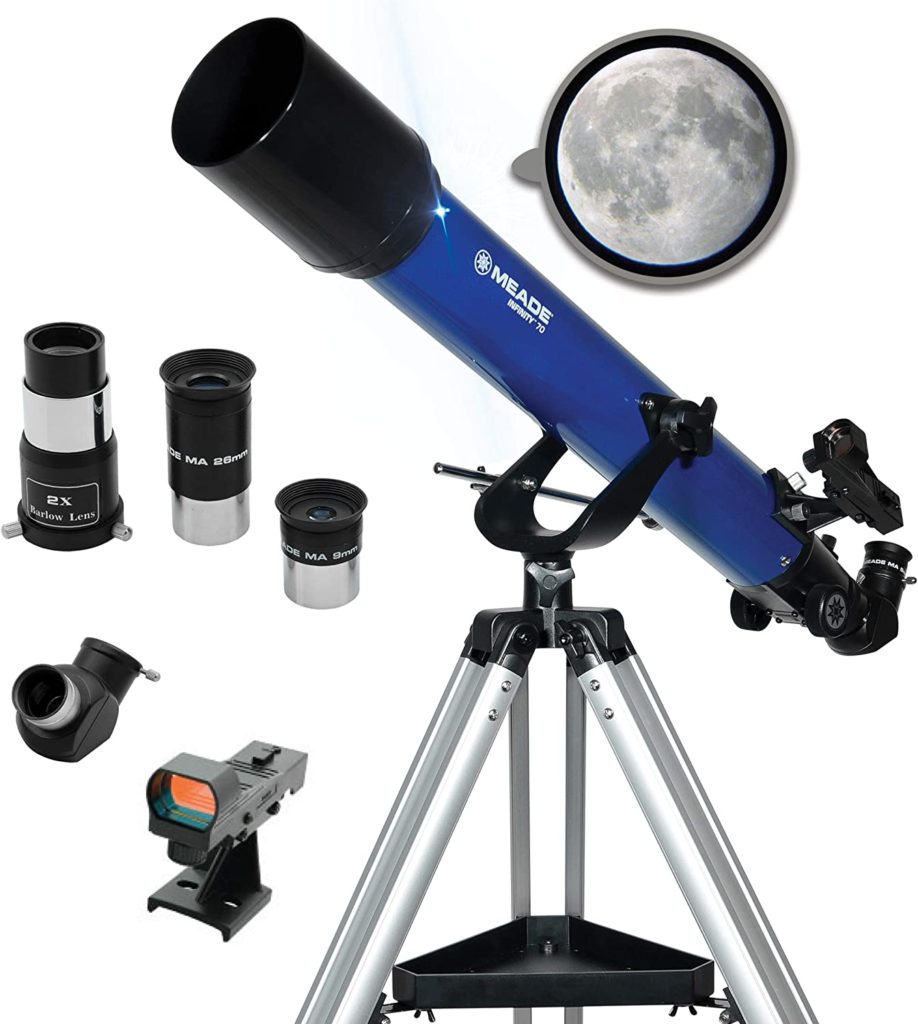
The Meade Instruments Infinity 70mm AZ Refractor also includes an auto start suite astronomy planetarium DVD which operates only on Windows PC. This software is made to guide the beginners to the basics of astronomy and instruct them how to use the telescope properly.
This planetarium DVD contains 10,000 celestial bodies to view and learn. This telescope also includes an accessory tray that holds the telescope’s accessories when observing and an infinite collection software.
The Infinity 70 will show you a lot of detail on the Moon, Mercury and Venus’ phases, as well as Jupiter’s cloud bands, the Great Red Spot, and its satellites, also the Saturn’s rings and its moon.
Pros:
- High-quality images for a beginner telescope
- Come with rack-and-pinion focuser
- Strong and durable stainless steel tripod
- Fold-down rubber cups to protect lenses
- Images are correctly positioned
- Easy to set up
Cons:
- Not suitable for Nebulae & Galaxies
Best For Astronomy
Celestron – PowerSeeker 70EQ
- Aperture: 70mm (2.8″)
- Focal length: 700mm
- Focal Ratio: f/10
- Mount: Equatorial
- Eyepiece: 20mm, 4mm
- Magnification: 35x, 175x
- Weight: 13.9 lbs.(6.3 kg)
- Our Rating: 9/10
Prices pulled from the Amazon Product Advertising API on:
Product prices and availability are accurate as of the date/time indicated and are subject to change. Any price and availability information displayed on [relevant Amazon Site(s), as applicable] at the time of purchase will apply to the purchase of this product.
The 70EQ Power Seeker is a refractor telescope with a 70mm aperture and a focal length of 700mm. Its low price combined with excellent optics, easy assembly, clear instructions, included eyepieces and other features that make it easy to use even for beginners, make it an excellent choice for anyone wanting to learn more about the nighttime sky.
At f/10, there is some chromatic aberration but nothing significant enough to ruin high-power views with this telescope. The optical quality of the Powerseeker 70 is quite good.
The scope’s focuser is a 1.25” rack-and-pinion made mostly of plastic. The focuser even includes a tension adjustment knob, should you find the focuser to be too loose or too tight.
Since Celestron 21037 PowerSeeker 70EQ telescope is a family-friendly scope, it is very easy to set up and use as it needs no extra tools. The instructions manual clearly describes every setup step, giving clear information on each of the telescope’s parts and uses.
With an aperture of 70 mm (2.76“) and a focal length of 700 mm (28”), the Celestron Power Seeker telescope allows stargazers to see the Moon, Jupiter, Saturn and other celestial wonders with ease.
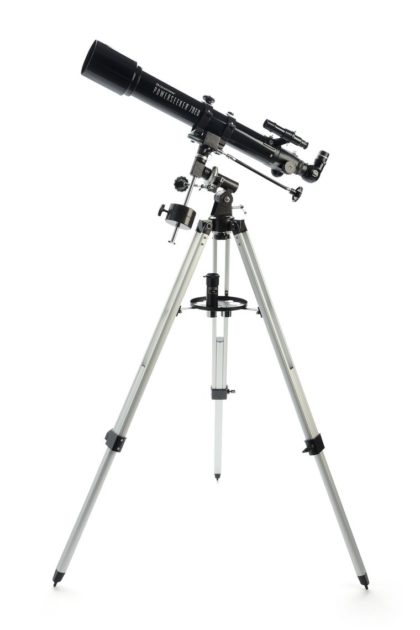
The 3x Barlow lens manages to triple the magnifying power of all eyepieces, while the 1.25″ Erect Image Diagonal makes the telescope ideal for both astronomical and terrestrial use.
The telescope includes fully coated optics, meaning that at least one lens in the telescope has been coated with multiple layers of substances designed to capture and focus the light that goes through the lens.
The equatorial mount supplied with the 70EQ is actually a good match for it. The motions are reasonably smooth, the mount’s extruded aluminum legs are quite steady with such a lightweight tube. Furthermore, the whole setup is pretty light at about 14 pounds.
The 70EQ PowerSeeker is the best small telescope for astrophotography as it comes with a camera attachment that allows the user to take photographs of the objects being viewed.
Pros:
- Family-friendly, easy to setup and use
- Coated glass, decent optical components
- EQ mount with slow motion controls
- Budget option refractor telescope for astrophotography
- High and low power eyepieces
- Ideal for both terrestrial and celestial viewing
Cons:
- Not suitable for professional use
- Most components are built with plastic
Best Small Telescope Buying Guide
Buying a telescope for home use is an important step towards a new level of appreciation for the night sky, and the wonders found within it.

Wondering what features you should look for in a telescope? It helps when you know precisely what to look for in a telescope before you spend a fortune buying it. Many people feel frustrated if the brand they purchased couldn’t fulfill its purpose, this can be daunting especially if you are a beginner. What telescope should you buy? You can use the following explanation as a guide to enable you to choose the right telescope.
Features To Consider When Choosing A Good Small Telescope
Types of Telescopes
There are three types of telescopes and each one has their strong and weak points. They are categorized by the abilities to gather light and the way they go about it.
Refractor scopes are better than every other type at viewing through light pollution. Also, they are ideal for planetary and lunar observations.
Reflector scopes, on the other hand, are perfect for deep-sky observation and don’t perform excellently with light pollution. These scopes require regular alignment and adjustment if used regularly.
Compound scopes utilize a mix of reflector and refractor elements. They’re great for general observation of the sky, and they perform well even in areas with light pollution.
Aperture
The most important aspect of any telescope is its aperture, the diameter of its main optical component, which can be either a lens or a mirror.
The aperture of a telescope is the diameter of the light collecting region, assuming that the light collecting region has a circular geometry . For an optical instrument, the aperture is the diameter of the objective lens (refracting telescope) or the primary mirror (reflecting telescope). The larger the aperture, the more light the telescope can gather, and the fainter the limiting magnitude of the instrument. The field of view of the telescope decreases as the aperture increases, but the resolving power increases.
Focal Ratio
Another feature you should consider is the focal ratio. It is known as the speed of the optics. This characteristic depends on the focal length. You should look out for this crucial feature, usually the longer, the better. Use the following as a guide for focal ratio range.
f/3 to f/5 = fast, but lower power; best for deep space photography and observing full field f/6 – f/10 = slow, but higher power; best for narrower field viewing, photography of the moon, the planets, and binary stars
Focal Length
The focal length of a telescope has a direct influence on the amount of magnification. Basically, what this means is that the longer the scope’s focal length, the higher its magnification.
Do not assume that the tube length of the scope is its focal length. Complex scopes, despite having short tubes, usually deliver a sharp and clear image. This means that longer focal length is achievable through the proper combination of lenses and mirrors.
Magnification
Magnification of a telescope is actually a relationship between two independent optical systems: the telescope itself and the eyepiece you are using. To determine power, divide the focal length of the telescope (in mm) by the focal length of the eyepiece (in mm).
By exchanging an eyepiece of one focal length for another, you can increase or decrease the power of the telescope.
For example, a 20 mm eyepiece used on a 1000 mm focal-length telescope would yield a power of 50x (1000/20 = 50). While a 10mm eyepiece used on the same instrument would yield a power of 100x (1000/10 = 100). Since eyepieces are interchangeable, a telescope can be used at a variety of powers.
Eyepieces
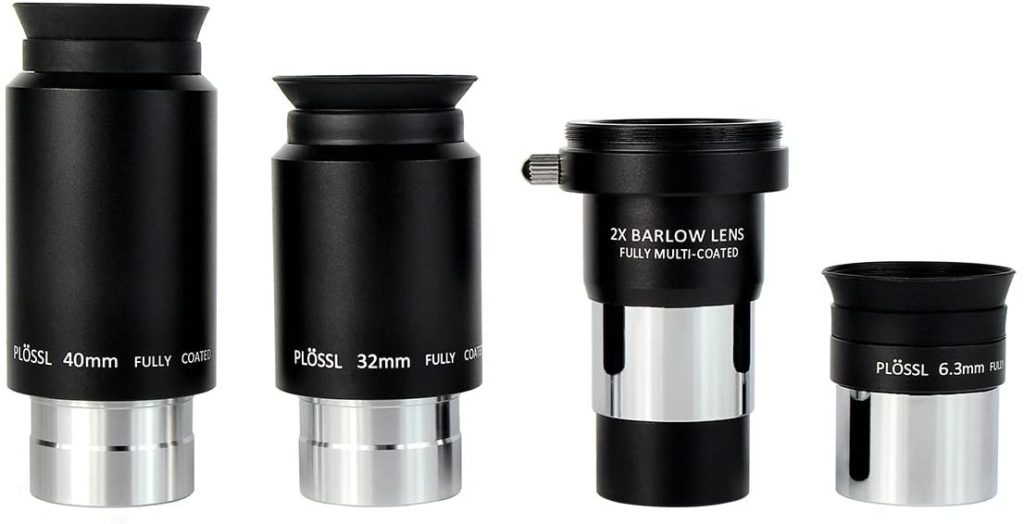
An eyepiece uses the light gathered and focused to magnify objects and generate images. Most models include one, or two eyepieces with one optimized for wider field views and the other for higher magnification.
The focal length of both the telescope and the eyepiece influences the level of magnification. To calculate eyepiece magnification, divide the telescope focal length by the eyepiece focal length.
Eyepieces with shorter focal length have higher magnification. That means a 10 mm is more powerful than a 25 mm. A Barlow lens is inserted into the focuser to double or triple the eyepiece magnification power.
Types Of Mounts
The mount is a very important part of the telescope. Some types of telescopes are better suited for a particular type of mount. There are 4 main types.
Alt-Azimuth Mounts:
Alt-azimuth mounts are the simplest type of mount, and they are similar to a camera tripod. They allow you to move the telescope up and down and side to side. But it can be difficult to track the stars and make precise adjustments. For this reason they are mainly suited for smaller, low-power telescopes.
Equatorial Mounts:
Equatorial mounts allow a telescope to track the sky as Earth rotates. They do this with motor drives but do not necessarily require a computer system to track, although some equatorial mounts are computerized for finding objects.
Most equatorial mounts are German equatorial mounts, which use counterweights to balance the telescope. This type of mount is versatile and breaks down into smaller pieces, making even large telescopes portable.
Dobsonian Mounts:
The dobsonian is a variation of the alt-az mount, designed for reflectors. Instead of using tripod legs, it uses a heavy base that is often made of wood. This is a stable design that doesn’t cost a lot and allows for more precise movements.
Fork Mounts:
A fork mount is designed for shorter tube telescopes (usually the compound type). They are motorized and do not require a counterweight since the telescope is balanced at it’s center of mass. But they are often heavier than other types of mounts.
Weight
Depending on the sort of person you are, this factor may or may not be important to you. If you are intending to use your scope at a specific place and not to ever travel with it, then the weight may not really be a point of focus for you. And besides, half the delight of having a telescope is in showing it off. For that, you may decide to travel with the scope.
Conclusion
Our top pick for the best small telescope for beginners is the Celestron – 80mm Travel Scope. The Celestron Travel Scope 80mm f/5 AZ Refractor Telescope Kit is designed for portability and ease-of-use for both astronomical and terrestrial use. Its refractor-style optical tube has a respectable aperture that gathers the amount of light required to ensure views of the moon and planets remain bright and clear.
Our second pick for the best small portable telescope is the Orion 10034 GoScope II. Kids and the whole family can still enjoy sharp daytime terrestrial views and night sky observations while on the road, and save storage space in the car by bringing along the pleasantly portable Orion GoScope II 70mm Refractor Travel Telescope Moon Kit. It’s a versatile 70mm-aperture refractor telescope designed to pack up and go whenever you hit the road, the trail, or even the air.
The Celestron – AstroMaster 90AZ is our next pick for the best small telescope for viewing planets. Designed as a capable and portable starter-scope, the Celestron AstroMaster 90AZ 90mm f/11.1 Refractor Telescope is a complete observational platform for making detailed observations of the Moon, planets, or comet-hunting.
ABOUT US
We are a team of active amateur astronomers, here to help you with all your astronomy and science related needs – this is anything, from reviewing the latest telescopes to be released to talking about gravity and neurons. The Big Bang Optics was started because of our love for astronomy and to help others like us find the best telescope and accessories.
LEGAL DISCLAIMER
The Big Bang Optics is a participant in the Amazon Services LLC Associates Program, an affiliate advertising program designed to provide a means for sites to earn advertising fees by advertising and linking to Amazon.com. The Big Bang Optics also participates in affiliate programs with Clickbank and other sites. The Big Bang Optics is compensated for referring traffic and business to these companies.

